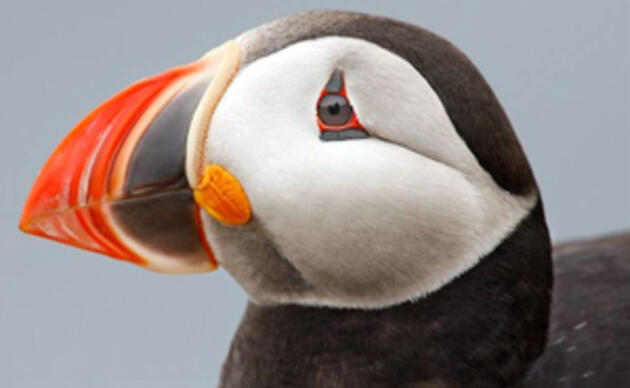OFFICIAL PRESS RELEASE
Manx Shearwater Nests Successfully for First Time In U.S. - Conservation Program Enables Historic Fledging of Manx Shearwater on Matinicus Rock, Maine
Rockland, ME --- 15 September 2009 -- On Tuesday September 8th, biologists visiting Matinicus Rock, an island off mid-coast Maine, discovered a fledgling age Manx Shearwater. While shearwaters were first observed on the island twelve years ago, this is the first time that a chick is known from the island and the first time that a Manx Shearwater chick is known to have reached fledging age (age at which a bird leaves its nest) in the United States. The young bird was found by a team of Audubon and U.S. Fish and Wildlife Service Researchers, as they checked suspected Manx burrows on the 22-acre island, which already holds the distinction of being Maine’s most diverse seabird nesting island.
Located 26 miles south of Rockland, Matinicus Rock is cooperatively managed by the National Audubon Society’s Seabird Restoration Program and the Maine Coastal Islands National Wildlife Refuge. The island was also the site, earlier this year, of the first eastern U.S. nesting of Common Murres in more than 100 years.
Scott Hall, along with Brian Benedict, Bob Houston, Matt Klostermann, and Lauren Scopel of the U.S. Fish and Wildlife Service, discovered the chick in a relatively shallow burrow – one of six burrows on the island. Upon first examination the shearwater appeared to be an adult - but a closer look revealed remnant patches of fluffy light gray down around the legs - proof that this was a nearly fledged chick.
"The young shearwater had a healthy appearance and perfect plumage as it nibbled on the U.S. Fish and Wildlife patch on my sleeve," according to Brian Benedict.
The team had waited patiently until the end of the 2009 nesting season to check the burrows, in order to avoid disturbing the shearwaters during the 120 days a pair needs to hatch and raise a chick to fledging. Because of this, they could have easily missed this historic event if they had checked the burrows even a few days later.
"This is what we all work and hope for;" said Stephen Kress, director of Audubon's Seabird Restoration Program, "This successful nesting provides further evidence of the health of the Gulf of Maine and demonstrates how Audubon's and the U.S. Fish and Wildlife Service's long term collaborative efforts are helping seabirds to thrive."
Manx Shearwaters (Puffinus puffinus) nest throughout the eastern North Atlantic, especially in Great Britain. These crow-sized albatross relatives have a wingspan of nearly three feet, and are named for their habit of flying low over the water. Studies in Britain indicate that they may live 56 years and travel over five million miles during their long lives. Regular visitors to the western North Atlantic since the 1950’s, their breeding was first confirmed in 1973 when a pair produced a chick on Penikese Island in Buzzard’s Bay, Massachusetts, but the outcome of this nesting was not confirmed. In 1977, a second North American and first Canadian breeding record was confirmed on Middle Lawn Island in Newfoundland. The species is not known to have nested in the United States since 1973, but a small population has continued to nest on Middle Lawn Island.
A Manx Shearwater was first observed on Matinicus Rock in May 1997 and a nesting burrow was discovered the following year. Two Manx were seen briefly together in 1999 and appeared regularly in 2000. From 2001-2004, shearwaters used the burrow on multiple occasions and an egg was found in the burrow in 2005, but it failed to hatch. In 2006 and 2007, up to 19 Manx Shearwaters were seen around the island. In 2008, a new burrow was found, and visiting adults were documented with an infrared camera, but breeding was not confirmed. Several adjacent burrows were discovered later in 2008. It was in one of these burrows that the fledgling was discovered.
Seabirds nesting on Matinicus Rock and other Maine seabird colonies are dependent on ample supplies of fish such as Atlantic herring and white hake, which they feed to their young. Despite the unusually wet summer, 2009 appears to have been a banner year for both Atlantic herring and Maine seabirds.
The mission of the U.S. Fish and Wildlife Service is working with others to conserve, protect and enhance fish, wildlife, plants and their habitats for the continuing benefit of the American people. We are both a leader and trusted partner in fish and wildlife conservation, known for our scientific excellence, stewardship of lands and natural resources, dedicated professionals and commitment to public service. For more information on our work and the people who make it happen, visit this Fish and Wildlife Service web site.
Now in its second century, Audubon connects people with birds, nature and the environment that supports us all. Our national network of community-based nature centers, chapters, scientific, education, and advocacy programs engages millions of people from all walks of life in conservation action to protect and restore the natural world.
Photos available upon request.
For more information contact:
Steve Kress, Director, Audubon Seabird Restoration Program: skress@audubon.org; 207-210-3569
Brian Benedict, Deputy Refuge Manager, Maine Coastal Islands National Wildlife Refuge: Brian_Benedict@fws.gov; 607-257-7308
Audubon: Delta Willis: dwillis@audubon.org; 212-979-3197
Learn about birds and take action
Adopt-A-Puffin
Adopt now and receive: A Certificate of Adoption, A biography of "your" puffin, and The book How We Brought Puffins Back To Egg Rock by Stephen Kress.
Visitor Center
The Project Puffin Visitor Center (PPVC) is located at 311 Main Street in downtown Rockland, Maine. The center opened its doors officially on July 1, 2006.



